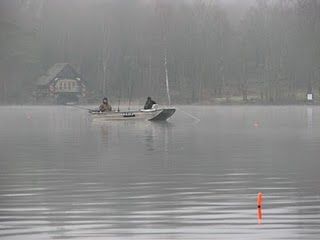Two contrasting weeks of piking have taught me a lesson which I needed to learn.
We’re well into January now and the pike season is at its height – a time when I should be making hay and getting some big fish in the boat. It’s been tough though and while results are picking up, they have done so at a slower rate than I would have liked.
The first week i was out with Denis for three days – three very wet days as it turned out. Fishing in the rain is never that much fun and when you’re out in a boat it’s worse still. My boat has a folding cuddy which keeps the worst of the rain off but when there are two of you, and baits and floats are spread around all over the place, the cuddy obscures your view and I don’t like to use it. Fishing a mixture of float legered baits and plain legered ones helps a bit but it’s not a big boat and there’s not much room for two under the shelter.
So it was that we both got wet, then wetter and finally wettest. Three wet days and it gets through even the best waterproofs and we were both glad to get home at the end of it. The quality of the fishing made it worse with just two single figure fish and a twelve pounder to me although Denis did better with four doubles up to fifteen pounds.
What was noticeable was that the fish we had came from deeper water than usual and that the usual productive swims were almost devoid of fish. I spent some time thinking about this and wondering why it had come about and eventually the old grey cells kicked into gear. The exceptionally cold winter has created a condition in our lakes which doesn’t always happen, turnover!
Turnover happens when the surface layers cool to four degrees centigrade, when water is at its densest. This causes a complete breakdown of any thermal stratification which has been present in the water column and leads to a total mixing of the upper and lower layers of the lake. This gives the pike access to the deeper layers which, ordinarily, they would avoid due to the very low oxygen levels that exist down there. Oxygen levels are high in the deep water after turnover and since there is food down there, in the form of Charr in particular, the pike will be spending much of their time very deep just now.
Turnover, if it happens at all in this country, usually takes place quite late in the winter after the coldest time of late January. If turnover takes place late, its effect is less pronounced since by early February light levels are starting to improve and we’re getting close to spawning time, thus making the shallow water attractive. This season I expect it happened in the first week of December, two months early and this will have had a big effect on the fish, both pike and preyfish. Armed with this thought I set forth on my second trip, another three day jaunt. No rain this time, indeed the weather was positively balmy, but I resolved to fish new swims and to fish deep. It paid off in terms of nu
mbers of fish but I didn’t get the big one I wanted. In three days I managed eight pike, all of them over ten pounds with the best five all over fifteen. These went 15.04, 15.10, 16.06, 17.00 and 17.06 All the fish came from swims I haven’t fished before and all came from deep water.

It looks like I might make sense of this season after all but there’s one other thing I have to mention. On a water whose size is measured in thousands of acres it really isn’t necessary to anchor up right next to someone else – as the people in this picture did. You can see my float in the foreground there, couldn’t they find their own swim?
Eric Edwards – Read Eric’s full pike blog Here.











